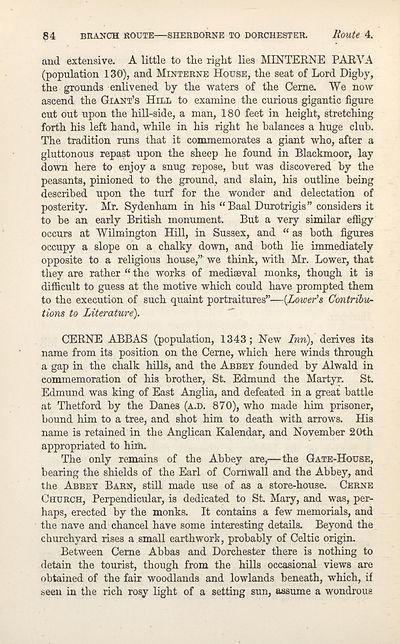Download files
Complete book:
Individual page:
Thumbnail gallery: Grid view | List view

84 BRANCH ROUTE SHERBORNE TO DORCHESTER. Route 4.
and extensive. A little to the right lies MINTERNE PARVA
(population 130), and Minterne House, the seat of Lord Digby,
the grounds enlivened by the waters of the Ceme. We now
ascend the Giant’s Hill to examine the curious gigantic figure
cut out upon the hill-side, a man, 180 feet in height, stretching
forth his left hand, while in his right he balances a huge club.
The tradition runs that it commemorates a giant who, after a
gluttonous repast upon the sheep he found in Blackmoor, lay
down here to enjoy a snug repose, hut was discovered by the
peasants, pinioned to the ground, and slain, his outline being
described upon the turf for the wonder and delectation of
posterity. Mr. Sydenham in his “Baal Durotrigis” considers it
to be an early British monument. But a very similar effigy
occurs at Wilmington Hill, in Sussex, and “ as both figures
occupy a slope on a chalky down, and both lie immediately
opposite to a religious house,” we think, with Mr. Lower, that
they are rather “ the works of mediseval monks, though it is
difficult to guess at the motive which could have prompted them
to the execution of such quaint portraitures”—{Lower's Contribu¬
tions to Literature).
CERNE ABBAS (population, 1343; New Inn), derives its
name from its position on the Ceme, which here winds through
a gap in the chalk hills, and the Abbey founded by Alwald in
commemoration of his brother, St. Edmund the Martyr. St
Edmund was king of East Anglia, and defeated in a great battle
at Thetford by the Danes (a.d. 870), who made him prisoner,
bound him to a tree, and shot him to death with arrows. His
name is retained in the Anglican Kalendar, and November 20th
appropriated to him.
The only remains of the Abbey are,—the Gate-House,
bearing the shields of the Earl of Cornwall and the Abbey, and
the Abbey Barn, still made use of as a store-house. Cerne
Church, Perpendicular, is dedicated to St. Mary, and was, per¬
haps, erected by the monks. It contains a few memorials, and
the nave and chancel have some interesting details. Beyond the
churchyard rises a small earthwork, probably of Celtic origin.
Between Ceme Abbas and Dorchester there is nothing to
detain the tourist, though from the hills occasional views are
obtained of the fair woodlands and lowlands beneath, which, if
seen in the rich rosy light of a setting sun, assume a wondrous
and extensive. A little to the right lies MINTERNE PARVA
(population 130), and Minterne House, the seat of Lord Digby,
the grounds enlivened by the waters of the Ceme. We now
ascend the Giant’s Hill to examine the curious gigantic figure
cut out upon the hill-side, a man, 180 feet in height, stretching
forth his left hand, while in his right he balances a huge club.
The tradition runs that it commemorates a giant who, after a
gluttonous repast upon the sheep he found in Blackmoor, lay
down here to enjoy a snug repose, hut was discovered by the
peasants, pinioned to the ground, and slain, his outline being
described upon the turf for the wonder and delectation of
posterity. Mr. Sydenham in his “Baal Durotrigis” considers it
to be an early British monument. But a very similar effigy
occurs at Wilmington Hill, in Sussex, and “ as both figures
occupy a slope on a chalky down, and both lie immediately
opposite to a religious house,” we think, with Mr. Lower, that
they are rather “ the works of mediseval monks, though it is
difficult to guess at the motive which could have prompted them
to the execution of such quaint portraitures”—{Lower's Contribu¬
tions to Literature).
CERNE ABBAS (population, 1343; New Inn), derives its
name from its position on the Ceme, which here winds through
a gap in the chalk hills, and the Abbey founded by Alwald in
commemoration of his brother, St. Edmund the Martyr. St
Edmund was king of East Anglia, and defeated in a great battle
at Thetford by the Danes (a.d. 870), who made him prisoner,
bound him to a tree, and shot him to death with arrows. His
name is retained in the Anglican Kalendar, and November 20th
appropriated to him.
The only remains of the Abbey are,—the Gate-House,
bearing the shields of the Earl of Cornwall and the Abbey, and
the Abbey Barn, still made use of as a store-house. Cerne
Church, Perpendicular, is dedicated to St. Mary, and was, per¬
haps, erected by the monks. It contains a few memorials, and
the nave and chancel have some interesting details. Beyond the
churchyard rises a small earthwork, probably of Celtic origin.
Between Ceme Abbas and Dorchester there is nothing to
detain the tourist, though from the hills occasional views are
obtained of the fair woodlands and lowlands beneath, which, if
seen in the rich rosy light of a setting sun, assume a wondrous
Set display mode to:
![]() Universal Viewer |
Universal Viewer | ![]() Mirador |
Large image | Transcription
Mirador |
Large image | Transcription
| Antiquarian books of Scotland > Adventure and adventurers > Black's guide to the counties of Dorset, Devon, & Cornwall > (106) |
|---|
| Permanent URL | https://digital.nls.uk/142587650 |
|---|
| Description | Thousands of printed books from the Antiquarian Books of Scotland collection which dates from 1641 to the 1980s. The collection consists of 14,800 books which were published in Scotland or have a Scottish connection, e.g. through the author, printer or owner. Subjects covered include sport, education, diseases, adventure, occupations, Jacobites, politics and religion. Among the 29 languages represented are English, Gaelic, Italian, French, Russian and Swedish. |
|---|

